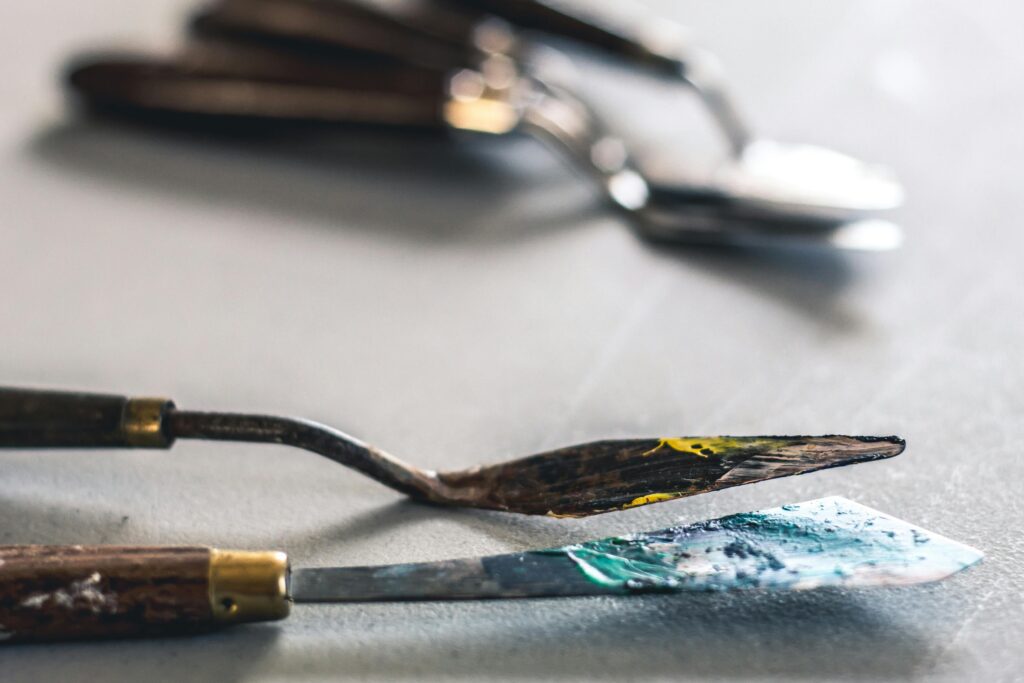6 Money Tips Every Artist Should Know

You know that feeling when the Wi-Fi suddenly cuts out in the middle of a video call? One second everything’s smooth, the next you’re frozen mid-sentence, wondering if anyone caught your awkward face. That’s pretty much what freelancing income feels like. One month you’re flowing, the next you’re buffering, and it always seems to happen right when you need stability the most.
Freelancers laugh about it all the time: the feast-and-famine cycle, the “great month followed by a ghost town” month, the panic that hits as soon as you dare to feel comfortable. It’s funny when you’re joking with friends, but less so when the rent reminder pops up.
Unstable income is the one consistent thing about freelancing.
But here’s the twist: unpredictability doesn’t mean you can’t build a plan. It just means your plan has to look different than your friend’s who works a steady office job. They might have predictable paychecks; you’ve got peaks, dips, and wild cards. The trick isn’t to fight that rhythm, it’s to design a system that works with it.
Think of it like riding a bike on uneven ground. You don’t quit the ride because the path gets bumpy, you adjust your balance and keep going. Financial planning for freelancers is the same. You can smooth the ride by knowing when to speed up, when to save energy, and when to just coast.
And the good news? The tools you need aren’t locked away in some financial textbook or reserved for people with massive incomes. They’re practical, everyday strategies you can start applying now, even if your bank account looks like a rollercoaster graph.
So let’s dig in , without the boring financial jargon and without the guilt trips. Just clear, doable ways to save and invest while freelancing, so you can stress less about the “buffering” moments and enjoy the months when things are actually flowing.

Why Does My Bank Account Look Like a Heartbeat Monitor?
Freelancing has a unique superpower: it makes your bank account look like a dramatic soap opera. One day it’s soaring, the next it’s fainting, and then out of nowhere it revives again. This isn’t a sign that you’re bad at freelancing, it’s simply how the rhythm works. The sooner you accept that volatility is normal, the easier it becomes to stop panicking every dip.
Instead of chasing stability where it doesn’t exist, start with observation. Track your income like you’d track your workouts or daily steps. Look back at six months of projects and you’ll see patterns, even if they look messy. Some months may consistently deliver more, while others slump. That’s your first real data point.
Once you see the cycle, you stop reacting with surprise. Think of it like knowing rainy season is coming. You may not control the clouds, but you know to carry an umbrella. Your “umbrella” is simply preparing for those dips by saving during peaks. Without that awareness, every dip feels like an attack.
It also helps to reframe what instability means.
Traditional workers think freelance income looks scary, but many employees lose jobs overnight.
At least with freelancing, you have multiple clients and streams, so you’re less tied to one paycheck. Instability isn’t failure, it’s flexibility in disguise.
So instead of beating yourself up about irregular income, lean into it. Accept it as the baseline, not the exception. That shift alone changes your stress levels because you stop expecting your bank account to behave like an office worker’s. It’s a freelancer’s account, and it’s allowed to have drama.
Once you see the drama as normal, you can move into strategy. And strategy is where the fun begins, because suddenly you’re no longer reacting, you’re preparing.
That’s when the chaos starts to feel like something you can actually ride instead of drown in.
The Two Bank Account Hack Nobody Warned You About
Here’s a freelancing truth nobody tells you at the start: your single checking account isn’t built for your rollercoaster income. That one account has to hold groceries, rent, taxes, and your weekend pizza orders, and it can’t separate what’s what. The result? You always feel like you’re spending “too much” but can’t explain where it’s going.
The fix isn’t fancy. You need two basic accounts: one for your personal life, and one for your freelance work. Every payment goes into the “work” account first. Then, you transfer only what you’ve budgeted for yourself into your “personal” account. This simple divide makes your money feel less like soup and more like separate plates of food.
When you only look at one big account, you can’t tell what belongs to the tax office, what belongs to you, and what’s just floating. With two accounts, you instantly know what’s spendable. No more late-night panic when you realize part of that “extra” money was actually reserved for quarterly taxes.
Some freelancers take it further by opening a third account for savings. That way, every time a payment arrives, they put aside a slice before it even hits their “fun money.” Think of it as paying your future self before your current self gets ideas about online shopping.
You don’t need a complex banking setup or a business degree. You just need to draw a clear line between “business” and “life.” It sounds small, but this separation is the first real step toward peace of mind. Otherwise, you’re constantly guessing what’s safe to spend.
And the beauty? Once the system’s in place, you don’t need willpower to keep track. It works in the background. Suddenly, you’re no longer looking at your bank app with dread. You know what’s yours, what’s untouchable, and what’s reserved. Clarity is worth more than the money itself sometimes.

Emergency Funds Aren’t Cute, But They’re Life-Saving
Nobody brags about their emergency fund at parties. You’ll never hear someone say, “Guess what, I’ve got six months of rent stashed away.” But ask any freelancer who’s lived through a client ghosting, a dry month, or an unexpected expense, and they’ll tell you the emergency fund was their real hero.
Think of it as your freelancing seatbelt. You hope you don’t need it, but when the crash happens, you’re grateful it’s there. Without it, a single dip in income can snowball into debt, stress, and frantic calls to anyone who owes you money. With it, you breathe. That breathing room is priceless.
The trick is building it without feeling deprived. Start small. Even if you’re only setting aside 5 or 10 percent of every invoice, you’re already building your buffer. The key isn’t the amount, it’s the consistency. Over time, those small slices pile up into a real cushion.
One of the best freelance hacks is treating “good months” as fuel for your emergency fund. When you get that juicy client project that pays more than usual, don’t upgrade your lifestyle. Pretend it never happened and move most of it into savings. Future-you will thank you when a client inevitably delays payment.
What makes the emergency fund powerful is how it changes your psychology. You make better creative decisions when you’re not panicking. You can say no to lowball offers, because you know you’re covered. It doesn’t just protect your wallet, it protects your dignity as an artist or freelancer.
At the end of the day, your emergency fund isn’t about preparing for the apocalypse. It’s about buying freedom from constant stress. And once you’ve tasted that, you’ll never want to go back to living without it.
If your idea of tracking income and expenses involves messy spreadsheets, receipts in a shoebox, or mental math that never adds up , there’s a smarter way. The Artist Income & Expense Tracker Template from ArtsToHearts is designed specifically for creatives, with customizable sheets for invoices, expenses, profit & loss, and monthly summaries. It helps you see exactly where your money comes from and where it’s going , so you stop flying blind and start budgeting with confidence. Use it in peak months to stash for lean ones, or during rainier spells to see where to cut back.
The Feast-or-Famine Budget Trick Nobody Teaches You
Every freelancer knows the cycle: one month you feel like a king ordering extra guac on everything, and the next you’re Googling “cheap dinner ideas with one potato.” That’s the feast-or-famine lifestyle, and it’s the enemy of financial calm. The solution isn’t earning more, it’s budgeting differently.
Instead of building your monthly budget on your best months, build it on your worst realistic month. Look back at your lowest income month in the past year and make that your “baseline budget.” That means if you could survive on that, everything above it becomes bonus fuel for savings or investments.
When you shift your perspective, the stress reduces instantly. Suddenly, every good month doesn’t just disappear into higher spending. You’re not saying no to fun, you’re saying yes to future stability. Treat the highs as “seeds” and the lows as the “soil.” Both are part of your freelance garden, but the seeds must be planted.
One way to hack this is by setting spending caps that don’t move with your income. For example, you always budget $X for rent, $Y for groceries, and $Z for extras, no matter how good a month is. If you earn more, great, but the caps don’t inflate. The difference gets tucked into savings.
This doesn’t mean you can’t treat yourself. In fact, the trick only works if you leave a small slice for joy. Otherwise, you’ll rebel against your own system.
A budget that feels like punishment will collapse. Think of it as “controlled fun,” like allowing ice cream but not a whole tub every night.
The best part? Over time, you start to feel like your finances are boring. And boring is beautiful. Because boring means stability, and stability means you’re no longer scrambling between feasts and famines. You’re quietly winning in the background.
Taxes: The Monster Under Every Artist’s Bed
Let’s be honest, the word taxes makes most freelancers sweat like they’re about to be called on in math class. And the biggest mistake? Pretending it doesn’t exist until April. Taxes are not a once-a-year event, they’re a slow drip, and if you don’t prepare, that drip turns into a flood.
The simplest survival move is this: set aside a fixed percentage of every payment the moment it lands. Whether it’s 20 or 30 percent depends on where you live, but the principle is the same. Move it out of sight, out of mind, into a separate account. That money was never yours to begin with.
Why is this so powerful? Because freelancers often see money as “theirs” until tax season comes knocking. But in reality, every invoice has invisible roommates: you, your bills, and the tax office. Pretend the tax share isn’t even yours. That mindset saves you from the stomach-drop feeling later.
If you want to level up, get into the habit of quarterly tax prep. Yes, it feels like overkill, but it spreads out the sting. Instead of a huge lump sum in April, you nibble away throughout the year. Less scary, more manageable, and your stress levels won’t spike every spring.

And here’s the underrated bonus: when you already have your tax money saved, you suddenly feel wealthier. Why? Because every dollar left after that is truly yours. There’s a strange confidence in knowing you’ve already handled the “monster.” It shrinks in size.
The freelancers who thrive aren’t the ones who earn the most, they’re the ones who treat taxes as part of the business system instead of a surprise. Once you flip that switch, you’ll never again dread opening that envelope.
Investing Isn’t Just for People in Suits
The biggest myth freelancers tell themselves is: “I’ll think about investing once my income is stable.” But here’s the twist , income rarely feels stable in freelancing. If you wait for the “perfect time,” you’ll wait forever. The truth is, investing is how you build stability, not what comes after it.
Start small. Even $50 a month makes a difference over years. The key is consistency, not size. Compounding is the quiet magician of finance, and it doesn’t care if you’re a Wall Street banker or a graphic designer working from a café. What matters is starting, not waiting.
Think of it like planting trees. You don’t wait until you have an orchard to start planting. You start with one sapling. The sooner you plant, the sooner you’ll have shade. Every month you invest, you’re putting down roots, even if you can’t see the branches yet.
There are also options tailored for freelancers. Retirement accounts (like IRAs, SEPs, or their local equivalents) let you save with tax benefits. That means you’re not only saving, you’re saving smart. It’s like getting a discount from the government for being responsible.
If traditional investing feels intimidating, start with micro-investing apps. They round up your coffee money into investments. It sounds small, but it gets you into the habit. You stop seeing investing as “for other people” and start seeing it as part of your freelance toolkit.
The mindset shift is this: investing isn’t about being rich, it’s about being future-proof. And as a freelancer, your future stability depends on the seeds you plant today. Waiting for stability before you invest is like waiting to get fit before you go to the gym.
Why Artists Need Paydays They Create Themselves
One sneaky problem of freelancing is this: there’s no regular payday. Money trickles in whenever clients feel like paying. That sounds freeing at first, but it also means you’re constantly in “random cash mode.” And random cash mode makes it really hard to budget.
The solution? Create your own payday. Pick a date twice a month or even monthly, and pay yourself like a boss would. Every client payment goes into your business account, but you only transfer your “salary” into your personal account on payday. That way, income feels structured.
This changes everything. Suddenly, your spending rhythm matches traditional workers. You know when you’ll “get paid,” even if the actual payments are erratic. It forces your money into a system that feels stable, even when it’s not.

The psychological relief is enormous. Instead of opening your banking app every morning to see if a client paid, you know your budget is already lined up. That predictability is what makes you stop feeling like you’re constantly behind. You become your own payroll manager.
The best part? You can adjust your salary as your income grows. At first, it might be modest. But as your freelance business strengthens, your payday amount can rise. It’s a built-in growth system, without the chaos of feast-and-famine spending.
At the end of the day, creating your own payday isn’t just a financial trick. It’s a mental health tool. Because nothing feels worse than uncertainty about when money is coming. Give yourself that certainty, and you’ll feel more in control than ever before.
Insurance: The Safety Net Artists Pretend They Don’t Need
Freelancers are great at winging it. You probably tell yourself, “I’ll deal with it if something happens.” But here’s the hard truth: one unexpected event can wipe out years of hard work. Without a safety net, even a minor accident or illness can derail everything.
Insurance isn’t glamorous, but it’s the shield that lets you keep freelancing without panic. Health insurance, disability coverage, and even basic liability protection are your allies. They don’t stop life’s surprises, but they stop those surprises from bankrupting you.
The freelancer mindset often defaults to short-term thinking. “I’ll get it later, when I’m making more.”
But later rarely comes. The smartest freelancers treat insurance like rent , not optional, not negotiable. It’s the cost of freedom.
And here’s the perspective shift: paying for insurance isn’t wasted money. It’s peace of mind. It’s the difference between sleepless nights over “what if” and a calm confidence that you’re covered. That emotional stability is as valuable as the financial one.
Start small if you have to. Maybe you can’t afford every type of coverage at once. Prioritize the essentials, and add on as your business grows. Even a little protection is better than none.
At the end of the day, insurance isn’t about fear. It’s about giving yourself permission to take risks in your work, knowing you’ve got a parachute packed if the unexpected drop comes.
Building a Emergency Fund (Your Safety Net)
Here’s a freelancer horror story we’ve all heard: laptop breaks down mid-project, client ghosts on payment, or a slow season lasts longer than expected. In those moments, the emergency fund is the unsung hero. Without it, everything becomes a crisis. With it, you just handle it and move on.
The rule of thumb is three to six months of expenses, but don’t let that number scare you. Start with even $500. That’s enough to cover small disasters like a broken phone or an urgent bill. The power of an emergency fund is psychological as much as financial.
Think of it like having a backup battery for your phone. You don’t always need it, but when you do, it saves the day. Suddenly, the panic isn’t as sharp, because you know you’ve got backup power in your pocket.

Here’s the secret: make it automatic. Set up a tiny transfer every time you get paid, even if it’s just 5 percent. Over time, those little bits snowball into real security. You won’t notice the drip, but you’ll notice the cushion when you fall.
And don’t confuse an emergency fund with savings for fun goals. This isn’t for vacations or new gadgets. This is your “break glass in case of emergency” stash. It’s sacred. Treat it like your business survival fund.
When freelancers say they finally feel free, it’s often because of this. Not a big client, not a big payday. It’s knowing that no matter what happens, they’ve got breathing room. That quiet superpower changes everything.
Future-Proofing: Freelance Isn’t Just for Right Now
Most freelancers live in the present. You’re focused on this month’s invoices, next month’s rent, or the client deadline looming tomorrow. But the truth is, freelancing is a career, not just a hustle. And careers need long-term vision.
Future-proofing means thinking beyond survival. It’s asking: How will I retire? What will my finances look like in 10 or 20 years? Will my future self thank me for today’s choices? Those questions might feel overwhelming, but ignoring them doesn’t make them disappear.
The good news is, future-proofing doesn’t require drastic changes overnight. It starts with small habits. Investing regularly, keeping debt manageable, upgrading your skills so your work remains in demand. Every small step compounds into long-term security.
One overlooked part of future-proofing is diversification. Don’t rely on one client, one income stream, or one type of work. Spread your risk. The more baskets you have, the less scary it feels if one tips over.
And here’s the best part: future-proofing isn’t just financial. It’s about mental freedom too. When you know your career has longevity, you stop scrambling and start creating with confidence. Stability breeds better work, not just better bank balances.
